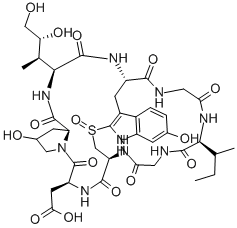|
|
| Product Name: | BETA-AMANITIN | | Synonyms: | BETA-AMANITIN;,12,17,18,19,20,21,22,23,23a-octadecahydro-29-sec-butyl-2,14-dihydroxy-21-(2,3;1-l-asparticacid-alpha-amaniti;8,20,23,24,27,30,33-octaoxo--dihydroxy-1-methylpropyl)-11-oxide;beta-amatoxin;B-amanitin from amanita phalloides;alpha-Amanitin, 1-l-aspartic acid-;beta-Amanitine | | CAS: | 21150-22-1 | | MF: | C39H53N9O15S | | MW: | 919.95 | | EINECS: | 244-244-8 | | Product Categories: | Cell Signaling and Neuroscience;DNA-RNA Transcription RegulatorsCell Signaling and Neuroscience;Gene Regulation and Expression;Mushroom;Toxins and Venoms | | Mol File: | 21150-22-1.mol |  |
| | BETA-AMANITIN Chemical Properties |
| Melting point | 300° | | Boiling point | 1599.6±65.0 °C(Predicted) | | density | 1.1725 (rough estimate) | | refractive index | 1.7400 (estimate) | | storage temp. | −20°C | | solubility | Water: 1 mg/ml | | pka | 4.02±0.10(Predicted) | | form | White to off-white powder. |
| Hazard Codes | T+ | | Risk Statements | 26/27/28 | | Safety Statements | 7-28-36/37/39-45 | | RIDADR | UN 3462 6.1/PG 1 | | WGK Germany | 3 | | RTECS | NJ8324000 | | HazardClass | 6.1(a) | | PackingGroup | I | | HS Code | 2934999090 | | Toxicity | LD50 i.p. in albino mice: 0.4 mg/kg (Wieland, Wieland) |
| | BETA-AMANITIN Usage And Synthesis |
| Acute toxicity | peritoneal-mouse LD50: 0.4 mg/kg; unnamed-mouse LD50: 0.4 mg/kg | | Uses | β-Amanitin from Amanita phalloides has been used:
- as a calibration standard for the quantification of β-Amanitin using liquid chromatography-high resolution-mass spectrometry/mass spectrometry (LC-HR-MS/MS) method.
- to determine its concentration in urine samples by capillary zone electrophoresis (CZE).
- in the analysis of β-amanitin in toxic mushrooms by liquid chromatography coupled to time-of-flight mass spectrometry.
| | Mechanism of action | β-Amanitin is a cyclic peptide found in several species of the Amanita genus, as well as other poisonous fungi. It inhibits RNA polymerase II and III but not RNA polymerase I or bacterial RNA polymerase, thus preventing mammalian protein synthesis. The biological activity of this toxin is similar to that of α-amanitin but differs structurally by the presence of a carboxyl group, which is useful for coupling reactions. | | Uses | As a tool in molecular biology. | | General Description | β-Amanitin belongs to the family of amatoxins. Amanitins are made of bicyclic octapeptides. β-Amanitin is composed of a carboxyl group and is acidic in nature. | | Biochem/physiol Actions | Toxic constituent of the mushroom, Amanita phalloides, inhibits eukaryotic RNA polymerase II and III, but not RNA polymerase I or bacterial RNA polymerase. Inhibits mammalian protein synthesis. |
| | BETA-AMANITIN Preparation Products And Raw materials |
|